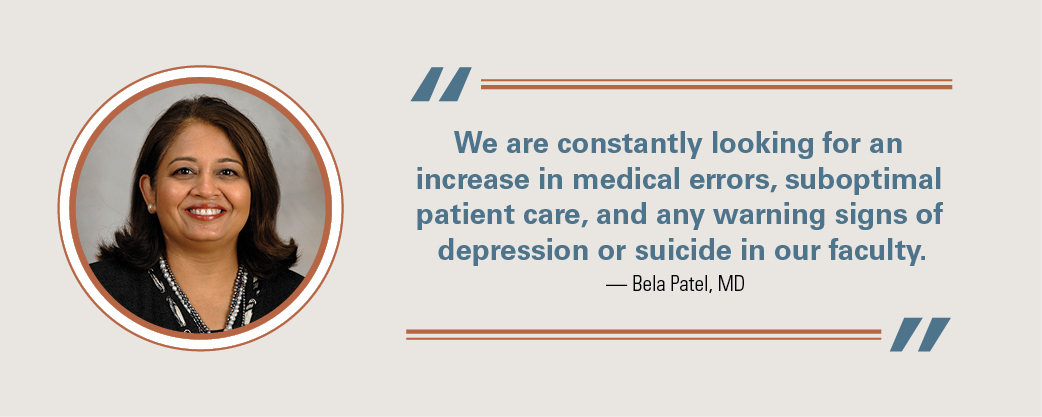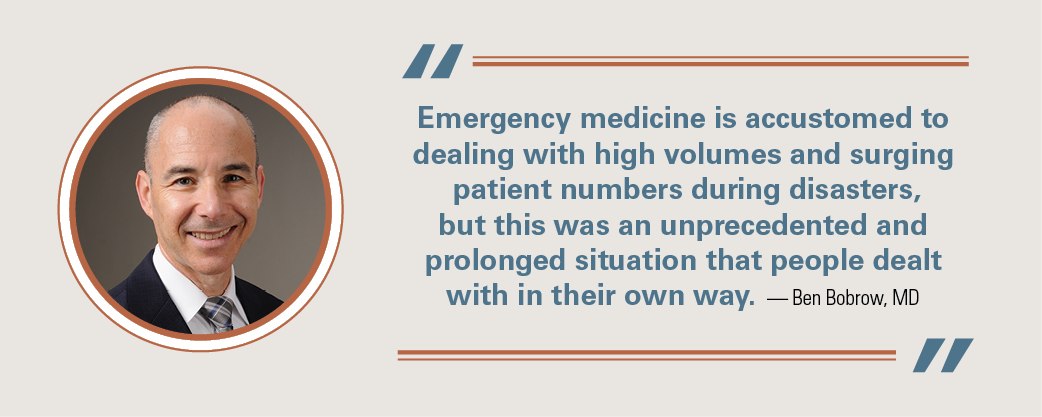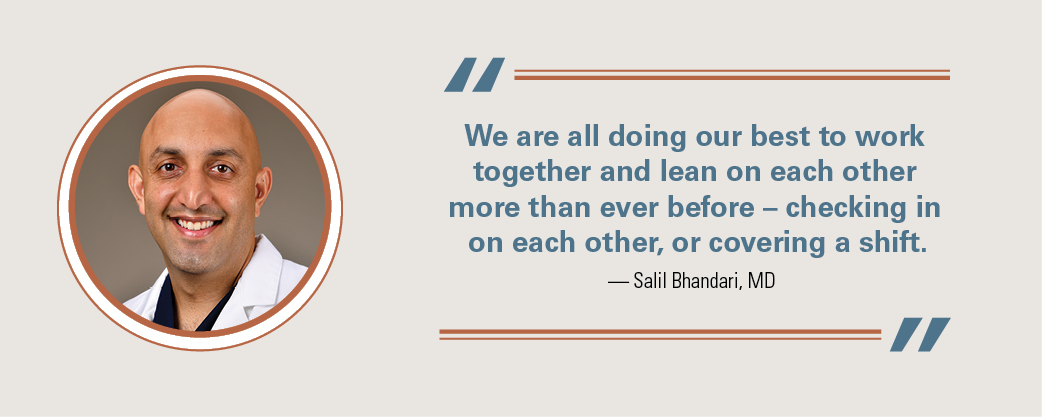The COVID-19 pandemic has tested the mettle, strength, and resilience of McGovern Medical School. From the nonstop front-line clinical care, to the research labs that never closed a day, to the students and staff who learned to pivot to new environments.
“Exhausting” is how emergency medicine physician, Salil Bhandari, MD, assistant professor, describes working through the pandemic. “It’s exhausting on many different levels – constant fear of getting COVID ourselves, staff changes in the hospital – having to cover, do extra shifts, and from the patient perspective – we want to help everyone, and that’s why we went into the field. It gets difficult when you see 50-60 people waiting in the emergency waiting room – no matter how hard you work, more patients are coming.”
The physical and emotional stress of working in a pandemic day in and out is something not lost on McGovern Medical School leaders who have witnessed heroic efforts and implemented measures to mitigate short- and long-term effects.

New Stressors
“Our physicians in the ICU were feeling burnout due to the intensity, volume, and high-acuity of patients,” said Bela Patel, MD, vice dean for healthcare quality. “Our critical care teams never experienced a pause in the pandemic to take a break because the cases kept coming.”
Ben Bobrow, MD, chair of the Department of Emergency Medicine, noted the persistent nature of both the pandemic and the front line. “Even though there was a lot of fear at the start, our faculty and staff kept showing up for work. And while some medical specialties had to shut down during the pandemic, the emergency department was always open to take care of everyone and in fact was busier than ever as patients had nowhere else to go for their urgent medical needs in addition to medical emergencies,” he recalled.
Physicians accustomed to working in a stressful environment of intensive care units felt additional pressures due to COVID-19 – changing clinical and operational procedures, loss of social connections to patients and their families, and a lack of a familiar team environment due to nursing shortages.
“In tough times, our doctors really rely on the strength they get from the patients and their families,” Patel said. “That wasn’t there during COVID because of the restrictions forbidding visitors. And our clinical teams that we had built up for years were gone – 80 percent of our nurses came to us from other locations as traveling nurses or from government sources and had to learn our system, adding extra stress.”
Patients were another source of stress. “Ninety-five percent of our hospital admissions were not vaccinated, and we were seeing an increase of mortality among young people and among mothers with young children at home. This brought on feelings of emotional exhaustion and hopelessness,” Patel said.

Rippling Effects
Burnout at work impacts patient care, showing up as decreased productivity, physician turnover, lower quality of care, and diminished patient satisfaction. Department leaders remain vigilant, recognizing the symptoms and causes.
“We are constantly looking for an increase in medical errors, suboptimal patient care, and any warning signs of depression or suicide in our faculty,” said Patel, the Graham Distinguished University Chair and professor of internal medicine.
Rates of depression and post-traumatic stress syndrome are known to be higher in health care employees as well as in first-responders than in the general population. Forty-four percent of medical school students report burnout as do about half of all physicians – and these are pre-pandemic levels. The risk of chronic stress is linked to substance abuse and suicide.
“Research shows that there is a significantly higher rate of suicide among EMTs and firefighters than the general population – we need to work with that data to help our frontline clinicians overcome the chronic stress they face at work,” Bobrow said.
Bobrow likened the stress of the pandemic to an iceberg – what we see at the surface is just a fraction of the whole.
“We have seen the negative effects of the pandemic play out across the country in suboptimal performance, stressed interpersonal interactions, physical deconditioning, substance issues, and absenteeism,” Bobrow said. “Emergency medicine is accustomed to dealing with high volumes and surging patient numbers during disasters, but this was an unprecedented and prolonged situation that people dealt with in their own way.”
Addressing Covid Related Trauma
Like most issues, the first way to combat the problem is to recognize it. At macro and micro levels, UTHealth Houston has placed a renewed focus on cultivating work community, promoting flexibility and work-life integration, as well as providing resilience and self-care resources.
“We are very aware to keep our own health as a first priority, because if we aren’t healthy, we can’t take care of patients,” Bhandari said, adding that normal ways physicians rest and recharge, such as travel, are not always available now.
Maintaining a team mentality helps. “We never thought it would last this long – the pandemic is like a hurricane that lingers around. We are all doing our best to work together and lean on each other more than ever before – checking in on each other, or covering a shift,” he said.

UTHealth Houston offers a myriad of wellness programs to faculty, staff, and students to help minimize the effects of the pandemic – from online yoga and meditation to counseling. The Department of Psychiatry and Behavioral Sciences created a special phone number and clinic hours dedicated to clinical employees seeking mental health care.
“We know that organization-driven interventions have better outcomes than physician-directed measures,” Patel said, adding that her department employs a variety of self-assessments to gauge stress and burnout levels.
The UTHealth Houston Faculty Assistance Program created a multi-faceted approach to provide supportive assistance.
“We strive to remove barriers that are commonly associated with seeking assistance, particularly for faculty who have unpredictable and hectic schedules,” said Robin Dickey, PhD, senior faculty assistance specialist. “We adapted efficiently and effectively to the uncertainty of the pandemic in order to meet the needs of the faculty, which included transitioning our free and confidential in-person mental health counseling and coaching services to a secure virtual platform, which are still ongoing.”
The program designed new opportunities such as grief and caregiver support groups; well-being and stress management presentations; schoolwide, a departmental, and division team outreach; an educational seminar series; and grand rounds. “The Faculty Assistance Program continues to be amenable to the needs of those seeking our services and we are available 24/7/365,” Dickey added.
Departments and divisions devised new ways to stay connected.
“In our department, we tried to get people together even if it was outside, just for a break. We hosted ‘quarantinis’ — a happy hour at home on Zoom to decompress and held team fitness challenges,” added Bobrow, holder of the John P. and Kathrine G. McGovern Distinguished Chair and the Nancy, Clive and Pierce Runnells Distinguished Professor in Emergency Medicine.
The residents in the Department of Emergency Medicine created a goal-based, four-week physical wellness initiative for themselves. The results of this program, published in the Journal of Wellness, showed that participants reported a lower emotional exhaustion score than non-participants on the Maslach Burnout Index.
Meditation is a new skill Bhandari has employed during the pandemic. “It helps me de-stress my mind and anxiety levels by being in a calmer space and being more mindful,” he said, adding that leaning on family and continuing to be physically active and eating healthy also help. “The problem is multifaceted and has hit us on many levels, so the solution must be multifaceted as well.”
The Trauma and Resilience Center, part of the Faillace Department of Psychiatry and Behavioral Sciences, reached out directly to Houston-area first-responders affected by the pandemic.

“Funding from the Texas Attorney General Office and Harris County Precinct 2 Commissioner Garcia’s Office allowed us to create an evidence-based psychotherapy program for first-responders suffering from PTSD, depression, substance abuse, and family problems – all of which have been exacerbated by COVID-19,” explained Ron Acierno, PhD, executive director of the center and professor of psychiatry.
Emergency departments and frontline COVID ICU staff were included in the project, which targets police, fire, and emergency medicine technicians offering Prolonged Exposure Therapy, Cognitive Processing Therapy, Written Exposure Therapy, Behavioral Activation, Cognitive Behavioral Therapy for Sleep, among others.
The high call-to-treatment conversion in this first-responders program has astounded the providers. In the first seven months, 74 front-line responders were screened for care, with 70 of those attending at least two sessions of therapy – and an additional 13 waiting for first appointments.
“You generally find a large number of folks who get screened, a smaller number who show up to the first appointment, and a much smaller number who then go on to be engaged in treatment,” said Deborah Little, PhD, professor of psychiatry and behavioral sciences. “It’s so very hard for these folks to make that first call let alone show up to the first appointment. It takes a tremendous amount of strength to do so.”
The demand and follow-through rates show the program is filling a critical need for first-responders.
“We had one participant who recently said it was night and day in terms of her ability to function,” Acierno said.